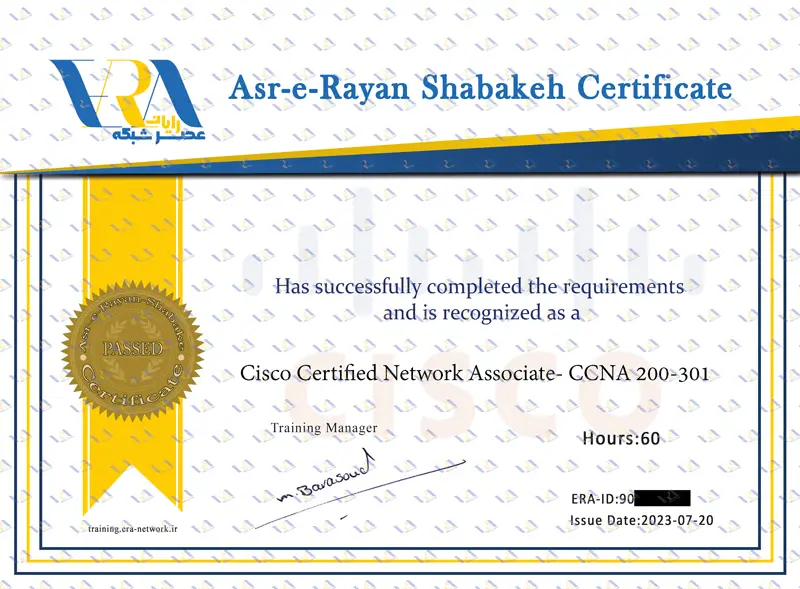
این دوره براساس سرفصل های رسمی شرکت سیسکو به صورت تئوری و عملی برگزار می گردد، به این صورت که در ابتدای هر مبحث، مطالب تئوری آن تدریس می شود تا با نحوه عملکرد دستگاه ها ، کاربردهای آنها در شبکه و نکات مهم آن آشنا شوید و بعد به پیاده سازی عملی آن با استفاده از نرم افزارهای شبیه ساز و تجهیزات واقعی با راهنمایی استاد، پرداخته می شود.
5,500,000 تومان
حضوری و غیر حضوری
60 ساعت
12 * 5
مقدماتی
+Network
گواهی آموزشی

کارشناسی ارشد فناوری اطلاعات
دوره آموزشی CCNA (Cisco Certified Network Associate) یکی از معتبرترین و پرطرفدارترین دورههای آموزشی در زمینه شبکههای کامپیوتری است که توسط شرکت سیسکو (Cisco Systems) ارائه میشود. این دوره به افراد علاقهمند به کار در حوزه شبکه، مهارتها و دانش لازم را برای نصب، پیکربندی، عیبیابی و مدیریت شبکههای کوچک تا متوسط میآموزد. شرکت در این دوره به دانشجویان کمک میکند تا تواناییهای لازم برای اجرا و نگهداری شبکههای کامپیوتری را به دست آورند و آمادگی کافی برای قبولی در آزمونهای مدرک CCNA را داشته باشند.
مدرک CCNA که اولین گام و پیشنیاز سایر مدارک سیسکو (CISCO) محسوب میشود، شامل اطلاعات پایهای در مورد شبکههای WAN و LAN و نحوه نصب و راهاندازی این نوع شبکهها تا سطح کوچک (کمتر از صد کامپیوتر) است. در دوره CCNA، مفاهیم سوئیچینگ و روتینگ و همچنین نحوه نصب و راهاندازی سوئیچها و روترهای سیسکو در لایههای دوم و سوم شبکه مورد بررسی قرار میگیرند. علاوه بر این، پروتکلهای ارتباطی شبکه نیز به سطح بالاتری نسبت به مدرک +Network آموزش داده میشوند.
این دوره براساس سرفصل های رسمی شرکت سیسکو به صورت تئوری و عملی برگزار می گردد، به این صورت که در ابتدای هر مبحث، مطالب تئوری آن تدریس می شود تا با نحوه عملکرد دستگاه ها ، کاربردهای آنها در شبکه و نکات مهم آن آشنا شوید و بعد به پیاده سازی عملی آن با استفاده از نرم افزارهای شبیه ساز و تجهیزات واقعی با راهنمایی استاد، پرداخته می شود.
مخاطبین دوره آموزشی CCNA شامل گروههای مختلفی از افراد میشود که در زمینه شبکه و فناوری اطلاعات فعالیت میکنند یا قصد ورود به این حوزه را دارند. این مخاطبین عبارتند از:


محتوای دوره مفید بود

دوره جامع بود ولی در بخشهای پیشرفته به مثالهای بیشتری نیاز داشتم

برخی مباحث خیلی عالی توضیح داده شده بودن

از دوره رضایت کامل رو داشتم فقط زمان استراحت کم بود
دوره CCNA نقطه شروع آموزشهای سیسکو است که مباحث پایهای و ضروری مانند نصب و پیکربندی تجهیزات شبکه، مفاهیم LAN و WAN و امنیت شبکه را آموزش میدهد و مقدمهای برای دورههای پیشرفتهتر CCNP و CCIE است.
در آموزش CCNA 200-301، مباحثی مانند نصب و پیکربندی روترها و سوئیچها، کنترلرهای وایرلس، مفاهیم شبکههای LAN و WAN، VPN، امنیت شبکه و برنامهنویسی تحت شبکه آموزش داده میشود.
پس از گذراندن این دوره از CCNA، دانشجویان مهارتهای لازم برای نصب، پیادهسازی و عیبیابی شبکههای سیسکویی را کسب کرده و فرصتهای جدید شغلی در حوزه شبکههای سیسکو برای آنها فراهم میشود.
پس از گذراندن دوره و قبولی در آزمون، دانشجویان مدرک CCNA 200-301 را دریافت خواهند کرد که تأییدیهای برای مهارتهای آنها در زمینه شبکههای سیسکو است.
دوره CCNA 200-301 شامل دو کتاب CCNA 200-301 Official Cert Guide, Volume 1 و Volume 2 است که مباحث کامل دوره را پوشش میدهند و برای آمادهسازی دانشجویان برای آزمون نهایی استفاده میشوند.
| نام دوره | پیشنیاز | روز های برگزاری | ساعت(دوره) | شروع دوره |
|---|---|---|---|---|
| CCNA 200-301 | Network+ | یکشنبه و سه شنبه 17 الی 20 | 60 | فروردین |
| CCNA 200-301 | Network+ | پنجشنبه 14 الی 19 | 60 | فروردین |
| CCNA 200-301 | Network+ | شنبه و دوشنبه 17 الی 20 | 60 | اردیبهشت |
| CCNA 200-301 | Network+ | پنجشنبه 9 الی 14 | 60 | اردیبهشت |
| CCNA 200-301 | Network+ | یکشنبه و سه شنبه 17 الی 20 | 60 | خرداد |
| CCNP Enterprise | Network+ | پنجشنبه 14 الی 19 | 120 | خرداد |
| CCNP Enterprise | Network+ | جمعه 9 الی 14 | 120 | خرداد |

مدرک عصر شبکه قابلیت ترجمه و استفاده برای امور مهاجرتی را نیز داراست. مدارک دورههای حضوری و آنلاین در این آموزشگاه هیچ تفاوتی با هم ندارند.
این دوره کسب مهارتهای لازم به منظور نگهداری، پشتیبانی و بهینهسازی از یک شبکه ارائهدهنده خدمات (Service Provider) را با تئوریها و کاربردهای عملی عمیقتری فراهم میسازد. در این دوره پیادهسازی معماریها، سرویسهای پایه، پروتکلها و راهحلهای موجود سیسکو در ارتباط با شبکههای ارائهدهندگان خدمات (Service Provider) مورد بررسی قرار میگیرد و همچنین در این دوره مباحث پیچیده مسیریابی (Routing)، انواع سرویسهای (Private WAN) و یا فراهم کردن بستری مناسب برای یک سازمان به منظور دسترسی به اینترنت و سرویسهای خارج از سازمان مورد بررسی قرار خواهد گرفت. این ccna دوره مناسب برای مهندسانی است که در زیرساخت شبکههای ارائهدهندگان خدمات (Service Provider) و یا اپراتورها در حال فعالیت هستند و یا قصد ورود به بازار کار در این حوزه را دارند.
به طور کلی این دوره مهارت هایی را برای نصب، عیب یابی و نظارت بر یک شبکه ایمن به منظور حفظ Confidentiality ،Integrity و Availability داده ها و دستگاه ها بررسی می کند. در این دوره مباحثی نظیر ایمن سازی زیرساخت های شبکه، درک مفاهیم اصلی امنیت، مدیریت دسترسی امن، رمزگذاری VPN، تنظیم اولیه و پیکربندی فایروال های سیسکو، جلوگیری از نفوذ و کنترل ترافیک، امنیت محتوای وب و ایمیل و امنیت کاربران را بررسی می کند، که صلاحیت یک فرد را در بکارگیری فناوری هایی را که سیسکو در زیرساخت های امنیتی خود استفاده می کند به چالش می کشد.
هدف در این دوره چگونگی تبدیل روتر سیسکو به فایروال و بحث های zone Based در شبکه های LAN و WAN صحبت خواهد شد. استفاده از معماری AAA و روش های ارتباط بین روتر سیسکو با پروتکل های Radius و چگونگی تبدیل کردن روتر سیسکو به IPS و تعریف و تحلیل IDS و همچنین تبدیل روتر سیسکو به VPN با امنیت معماری IPS از اهداف این دوره می باشد.
آموزش سیسکو ccna تحلیل شبکه توسط نرم افزاری مانند Syslog ،SNMP و Net flow از مباحث مناسب کارشناسان NOC و SOC می باشد. حتی در سازمان های کوچک و متوسط هم برقراری امنیت شبکه سر لوحه کار مدیران و مهندسان شبکه می باشد، در حالی که سازمان های بزرگتر به احتمال زیاد دارای تیم های سایبری و متمرکزتری با سرپرستان ویژه امنیتی هستند، از این رو این دوره برای تمامی مهندسینی که قصد ورود حرفه ای تر به دنیای شبکه را دارند توصیه می شود.
این دوره به گونه ای طراحی شده است که به تکنسین ها آموزش نصب، پیکربندی و نگهداری اجزای شبکه به منظور برقراری ارتباطات صوتی و تصویری مبتنی بر راه کارهای سیسکو را آموزش دهد. همچنین، آموزش شبکه ccna در این دوره پیاده سازی زیرساخت های یک پارچه برای مکالمات صوتی و تصویری به کمک معماری های ارائه شده توسط سیسکو بررسی می شود.
همچنین مفاهیم بنیادی انتقال صدا بر روی بستر آی پی (VoIP) و کنفرانس ویدیوی به همراه پیکربندی و عیب یابی دستگاه ها و سرویس های وابسته از جمله مواردی هستند که در این دوره مورد بحث قرار می گیرند. این دوره مناسب برای افرادی است که قصد ایجاد یک بستر مناسب برای ارتباطات صوتی و تصویری را بر مبنای تجهیزات سیسکو در دستور کار خود دارند و یا در اپراتورها و ارائه دهندگان خدمات در حال فعالیت هستند.
• Prepare and install Nano Server, a Server Core installation, and plan a server upgrade and migration strategy
• Describe enterprise storage solutions, and select the appropriate solution for a given situation
• Implement and manage Storage Spaces and Data Deduplication
• Install and configure Microsoft Hyper-V
• Deploy, configure, and manage Windows and Hyper-V containers
• Describe the high availability and disaster recovery technologies in Windows Server 2016
• Plan, create, and manage a failover cluster
• Implement failover clustering for Hyper-V virtual machines
• Configure a Network Load Balancing (NLB) cluster, and plan for an NLB implementation
• Create and manage deployment images
• Manage, monitor, and maintain virtual machine installations
• Plan and implement an IPv4 network
• Implement Dynamic Host Configuration Protocol (DHCP)
• Implement IPv6
• Implement Domain Name System (DNS)
• Implement and manage IP address management (IPAM)
• Plan for remote access
• Implement DirectAccess
• Implement virtual private networks (VPNs)
• Implement networking for branch offices
• Configure advanced networking features
• Implement software defined networking
• Install and configure domain controllers
• Manage objects in AD DS by using graphical tools and Windows PowerShell
• Implement AD DS in complex environments
• Implement AD DS sites, and configure and manage replication
• Implement and manage Group Policy Objects (GPOs)
• Manage user settings by using GPOs
• Secure AD DS and user accounts
• Implement and manage a certificate authority (CA) hierarchy with AD CS
• Deploy and manage certificates
• Implement and administer AD FS
• Implement and administer Active Directory Rights Management Services (AD RMS)
در دوره CCNA Data Center در مورد زیرساخت های فیزیکی مرکز داده، مفاهیم بنیادی شبکه مرکز داده و شبکه های ذخیره سازی در مرکز داده صحبت خواهد شد. طراحی و پیاده سازی شبکه مراکز داده نیازمند طیف گسترده ای از مهارت ها می باشد که در این دوره، بخش قابل توجی نظیر برقراری ارتباطات بین اجزای شبکه یک مرکز داده، پیکربندی تجهیزاتی همچون مسیریاب ها، سوییچ ها و یا پیکربندی سرویس های مختص شبکه مرکز داده بررسی می شود. مباحثی از جمله Unified Computing، مجازی سازی شبکه در مرکز داده، فناوری ها و راه کارهای سیسکو مختص مرکز داده، اتوماسیون و WorkStation مراکز داده بررسی می شود.
این دوره در دو بخش برگزار می شود، در بخش اول با عنوان DCICN مباحث TCP/IP ,Ethernet ,Vlanning ,Basic Router Configuration تدریس می گردد. این بخش دارای اشتراکات زیادی با CCNA R&S است و در بخش دوم با عنوان DCICT به مباحث جدی تر پرداخته می شود.
از آن جمله می توان به Cisco Data Center Fundamentals Concepts Data Center Unified Fabric، Storage Networking، DC Virtualization، Unified Computing، Data Center Network Services اشاره کرد. این دوره مناسب برای مدیران و مهندسانی است که در حال نگهداری شبکه مرکز داده (مبتنی بر تجهیزات سیسکو) می باشند و یا قصد راه اندازی یک مرکز داده در مقیاس کوچک تا متوسط را دارند.
916-640DCICT
Introducing Cisco Data Center Networking (DCICT)
911-640 DCICN
Introducing Cisco Data Center Networking (DCICN)


به نظرم دوره خیلی خوب بود